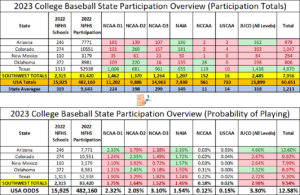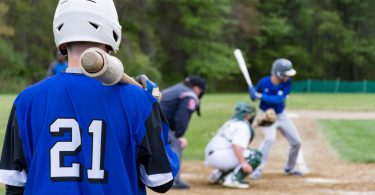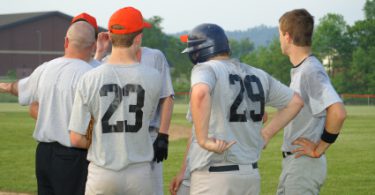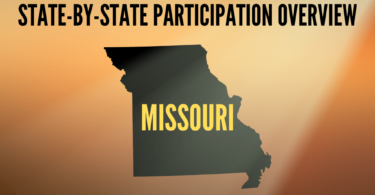You’re interested in playing college baseball, but what are your chances of making it to the next level? While many tout national probability as gospel, it turns out your odds of playing at the next level vary greatly depending on where you live.
If you live in the Southwest region and are wondering what percentage of high school graduates from your state play at each college level and where they are playing, you’ve come to the right place. In this article, we team up with our friends at College Baseball Insights to provide you with state-level overview of your chances to play at the next level.
For each of our Southwest states below, we break down:
- High school baseball participation by state
- Number of HS graduates from each state participating at each level of college baseball
- The odds of playing at each level of college baseball for high school graduates from every state
- An overview of player participation trends compared to the national and regional averages
You can see an overview of our resources, methodology, and limitations on our College Baseball Participation Overview Main Page.
Southwest Region Overview
With 83,420 high school baseball participants, it may surprise you to find out the Southwest region is the 3rd most populated of our 7 regions, trailing only the Midwest and Southeast regions. The Southwest states account for 17.3% of all NFHS high school baseball players nation-wide but graduates from these states make up only 13.1% of all college baseball participants. The probability of players from the Southwest Region moving on to play college baseball at any level (9.54%) is below the national average (12.58%) by a wide margin, finishing dead last of all 7 regions. While Texas is the state that most would expect to be the biggest college baseball pipeline in the Southwest, Arizona is the only state in the region with an overall college baseball participation rate above the national average. In fact, Arizona is the only Southwest participation rate in double digits.
Outside of Arizona, the Southwest gives us very little to get excited about from a participation rate perspective. The Southwest participation rate for every single major level of college baseball is below the national average. The JUCO (2.98%) and NAIA (1.45%) levels are where the Southwest gives the national average the best run for its money, but these still rank a respective 4th and 5th out of the seven regions. The Southwest ranks 5th for D1, 6th for D2, and tied for last for D3. It should be noted that the Southwest is the 2nd best region at sending players to the NCCAA level, even though that level in its entirety only has 561 U.S.-born players.
It’s hard to imagine getting to the third paragraph of a Southwest regional college baseball overview without major mention of Texas, but here we are. Texas is indeed a force in college baseball, but only because it has the most high school baseball participants (52,938). That’s nearly 10,000 more than California. In fact, the state of Texas has more high school participants than 3 of our regions in their entirety. In raw numbers, Texas does indeed dominate the college landscape, but that doesn’t hold up per capita. Texas’ participation rate is actually below the national average for every major level of college baseball. We’ll get to that more later, but the biggest thing to note is that because it accounts for 5/8 of the region’s high school ballplayers, Texas has a huge influence on what the regional statistics look like.
You can see the complete breakdown of the Southeast Region below, where boxes in green are above the national averages and boxes highlighted in red are below the national averages. Due to small overall participation numbers, we did not color code probability boxes for the NCCAA and USCAA levels.
Regional Comparison
Below, you can see how the Southwest matches up against other regions from around the country.

Below we provide an advanced breakdown of each state (listed in alphabetical order). To read the complete article on each state, simply click on the state name!
Arizona
It may surprise you to find out that Arizona has the 2nd lowest high school baseball participants of any state in the region, ahead of only New Mexico. That doesn’t stop Arizona from being the lone bright spot and clear leader of the Southwest in moving players to the college ranks. Arizona’s 12.6% overall college baseball participation rate is just about even with the national average of 12.58%, but sets the pace in the Southwest by over 2.5 percentage points. Arizona’s strongest pipeline to the next level comes at the JUCO level, where the state has a 4.66% participation rate (1st in the region). The Grand Canyon State also has a strong pipeline to the NAIA, with a 2.39% participation rate (1st in region). The state’s D1 participation rate of 2.33% is also ahead of both the national (2.32%) and regional (1.75%) averages and is also tops in the Southwest. At the D2 level, Arizona (1.79%) is above the regional mark (1.64%) but below the national average (2.05%). The D3 level is where Arizona is the worst (1.38%) at sending players to the next level. Thats good enough for 3rd in the region.
Arizona is a professional baseball Mecca, but that same success doesn’t extend to moving high school players to the college game. Despite leading the Southwest, Arizona is very average when compared to the other 49 states. This is likely due to poor in-state options for players. There are 3 D1, 5 NAIA, and 14 JUCO programs in-state. There are no D2 or D3 options.
Colorado
You may be surprised to find out that Colorado has more high school baseball participants than Arizona. Colorado’s 10,551 high school baseball players is good for 2nd in the Southwest behind obvious frontrunner Texas, whose participation numbers top every other state by a wide margin. Colorado is 2nd in the region in overall college baseball participation rate at 9.92% across all levels. If that seems low for a 2nd place state, it is. The national average is 12.58%. The only two levels where Colorado does well at moving players to the college ranks compared to the national average is Division 2 and NAIA. At the D2 level, Colorado’s 2.55% participation rate is above the national D2 average (2.05%) and the best of any state in the Southwest. For NAIA, Colorado’s 1.72% is above the 1.54% national average, but nothing to write home about. Still, it’s the 2nd best NAIA mark in the region behind Arizona. For all other major levels of college baseball, Colorado is below both the national and regional averages. At the D1 level, Colorado’s dismal 1.24% participation rate is 3rd in the region. At the D3 level, the 1.49% participation rate is 2nd in the Southwest but well below the national average of 3.10%. At the NAIA level, Colorado sports a 2.87% participation rate. That’s 3rd in the region and below the national mark of 3.30%. The Centennial State’s lack of success at moving players to the college level is because the college programs per capita in Colorado is one of the lowest in the nation. There are only 15 college baseball programs in-state– 2 Division 1, 8 Division 2, and 5 JUCO’s. There are no D3 or NAIA programs. With the Rockies dividing Colorado from some of the college baseball-rich states like California, it makes sense that the numbers would be low.
New Mexico
New Mexico’s 7.99% overall college baseball participation rate is the lowest in the region and among the lowest of any state where NFHS exists. The state is also last in the Southwest region in high school participation with just over 3,000 high school players. The NAIA is the only college level where New Mexico is above the national (1.54%) and regional (1.45%) averages. Every other level paints a pretty bleak picture. Here’s how participation rate at the other levels shake out: D1 (1.10%, last in the region), D2 (1.92%, 3rd in the region), D3 (0.72%, 4th in the region), and JUCO (2.64%, last in the region). With geographic isolation and only 8 in-state college baseball programs (2 D1, 2 D2, 0 D3, 1 NAIA, and 3 JUCO), it makes sense that New Mexico high school players struggle to make it to the next level compared to the rest of the country.
Oklahoma
Oklahoma’s 8.97% overall college baseball participation rate is the second lowest in the region behind New Mexico and well below the 12.58% national average. Not everything is negative in the Sooner State, though. At the D2 (2.45%, 2nd in the region) and JUCo (3.32%, 2nd in the region) levels, the participation rates are above regional and national averages. It’s also 1st in the Southwest at the NCCAA level with a .31% participation rate. All other levels are comparatively poor. Oklahoma’s 1.21% D1 participation rate is 4th in the region and a full percentage point below the national average. 0.18% of Oklahoma baseball players move on to the D3 level. That’s the worst rate of any NFHS state in the entire country. At the NAIA level, Oklahoma sends players at a 1.50% clip. That’s just below the national average, but since that’s a level where the Southwest does okay, its only 4th in the region, although still above regional average. Oklahoma has 3 D1, 11 D2, 7 NAIA, 1 NCCAA, and 11 JUCO programs at the college level. Even with a decent number of places to play for the number of high school participants, it seems that Oklahoma ballplayers are losing some of those opportunities to players from out of state.
Texas
Everything is bigger in Texas, right? When it comes to high school baseball participation, that’s undoubtedly true. Texas has a whopping 52,938 high school baseball players. The Lone Star State also has 94 college programs in-state, including 22 D1’s, 9 D2’s, 16 D3’s, 10 NAIA’s, 2 NCCAA, and 35 JUCO’s. While that sounds like a lot, it’s not nearly enough to support the robust high school baseball numbers. California, by comparison, has 61 more college programs in-state for 8,000 fewer high school baseball participants. While everyone knows Texas boasts some of the best programs baseball has to offer from Little League to the Big Leagues, and certainly at every level of college baseball, the state’s sub-par college baseball participation rates boil down to a simple supply and demand issue.
Texas’ overall college baseball participation rate of 9.20% ranks 3rd in the Southwest behind both Arizona and Colorado. That’s more than 2 full percentage points below the national participation rate of 12.58%. In fact, Texas doesn’t have a single major level of college baseball where its participation rate is greater than the national average. At the D1 level, its 1.90% participation rate is 2nd in the region and above the regional average (1.75%), but below the 2.32% national average. Texas’ 1.82% D3 participation rate is tops in the Southwest, which has an average participation rate of 1.52% for the D3 level. At the D2 (1.29%, last in the region), NAIA (1.24%, last in the region), and JUCO (2.72%, 2nd to last in the region) levels, Texas doesn’t perform well comparatively. Texas’ 0.22% participation rate at the NCCAA level is above national average and good for 2nd in the region, but that’s only talking about 119 players from Texas playing at that level.
So how should we judge Texas compared to the other big baseball states? Texas’ college baseball participation rates are low, there’s no doubting that. Still, Texas high school graduates are impacting programs in every state at every level. With 4,870 players in college baseball, Texas trails only California in-terms of total number of players moving on to college baseball. If that’s not a significant impact, I’m not sure what is. We’ll leave the final judgment on the Lone Star State’s college baseball pipeline up to you.
Limitations
This article was written with data and insights from 3rd party sources, College Baseball Insights and NFHS High School Participation Data. Data and insights are subject to revision and/or change. We’ve attempted to display as accurate a picture as possible with the information that is available. Readers should be aware that college baseball roster data is fluid and changes throughout the year. Every attempt is made to reconcile data and keep up with changes, but this article may not reflect the changes or updates from 3rd parties. Insights cannot account for gap year programs, misreported roster information, or other inaccuracies which may slightly alter the numbers and percentages used in this article. Insights are subject to change and are based on best available information.








